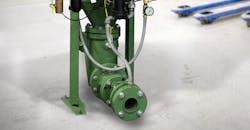Most foundry personnel are familiar with the dilute-phase pneumatic sand transporters that are common in many sand-casting plants – and they are acutely aware of the maintenance issues created by these systems. But there is a growing awareness of the quality and cost reduction advantages offered by dense-phase pneumatic transporter technology.
Dilute-phase sand conveyance produces material velocities over 4,000 fpm in the pipeline, which is highly detrimental to the piping as well as the product it is transporting. In contrast, the Klein Plug FloÒ dense-phase pneumatic transporter requires around 100 to 450 fpm and provides a much gentler handling of the sand. That more forgiving sand handling significantly reduces the generation of fines during transport.
The operational benefits driving the market to dense-phase transporters include:
• Reduction of sand fines, lowering casting cost and improving quality
• Reduced silica exposure that improves the work environment and safety
• Lower maintenance and operating costs that provides additional resources
Historically, to foundry managers, the most important of these has been reducing maintenance for dilute-phase systems – decreasing the weekly costs of repairing piping and elbows blown-out by the “hurricane in the pipe” operation; and dealing with the common, “sand on the roof” issue, to avoid an imminent collapse of the roof. High-velocity sand blasts holes into pipes and elbows while also fracturing sand grains and degrading sand quality.
A secondary benefit to switching to dense-phase transport is reducing workers’ exposure to silica, as required by OSHA’s newer Personnel Exposure Limits. However, now the focus has shifted to reducing the production of fines in a foundry’s sand system, which provides a slew of economic and quality benefits for metalcasting. The dense-phase transporter solves all three of these issues for sand-casting operations, but let’s take a closer look at the problems presented by the generation of additional sand fines.
Excessive fines generation is the bane of efficient sand molding. Whether the plant has a green sand, no-bake, or core process, reducing fines generation in the sand system can be a very significant driver of cost savings and quality improvements. The most significant production cost benefits of reducing fines generation will be: 1) Reduced binder requirements and gas generation; 2) Increased permeability and thus venting; 3) Lower mixing time/energy input required; 4) Enhanced shakeout and collapsibility; and 5) Scrap reduction and less cleaning room time.
With no-bake molds and cores, cutting chemical binder requirements will provide a significant cost savings. It will reduce gas generation in the mold and increase permeability, or the ability of the gas to pass through the sand and escape the mold, while improving surface finish. Besides the size of the sand particles, the main control over finish quality are the size and quantity of voids between the sand grains. The quantity, size, and types of voids are a major factor in controlling expansion issues. Too many fines will clog up these voids and prevent the proper venting of the gas.
Silica sand grains expand when heated by the molten metal and unless some space is allowed for this expansion, there will be a rupture in the mold surface. Most of this expansion can be handled by the mold voids if there is some control over fines generation.
In green-sand molding, an increase in the fines will result in more clay binder and a dramatic rise in moisture demand, while decreasing permeability. This is very significant, since water will expand 1600 times its volume when the molten metal converts it to steam. That steam, or gas, will try to escape the mold; if the permeability is insufficient, the gas will condense a few layers back in the mold, degrade the integrity of the mold wall, and create expansion defects. In aluminum casting the steam will provide hydrogen for the metal to absorb on the surface and create surface pinhole porosity.
When reducing fines generation, more cost savings can be found in the reduction of required mixing or mulling time and the energy input necessary to create the proper bonding characteristics for your process. When one is mixing or mulling sand with a binder, it is an attempt to coat as many sand grains as possible in the shortest amount of time. More fines will substantially increase the surface area that is necessary to coat while negatively impacting the time and amount of binding material required. More mixing or mulling time requires additional energy to achieve the proper results.
Shakeout and mold/core collapsibility also will be improved by reducing sand fines. The metal will burn-off the lower binder content more efficiently while increased permeability will mean fewer binder bridges need to collapse during shakeout. This also could reduce waste to be landfilled and lower the requirements for new make-up sand.
Probably the most significant cost savings from reducing sand-fines generation will be in scrap reduction and the very noticeable decrease in cleaning room time. The production increases right on the foundry floor, rather than by recovering value in the cleaning room. Reducing the number of times castings must be touched before shipment also will provide some control over the plant’s internal labor demand.
However, and most important, because dense-phase sand conveyance reduces fines generation and provides all the process improvements associated with that reduction, it will allow the foundry to produce more saleable castings and ship them to buyers in less time, at higher margins.
Jim Gauldin is the chief sales engineer with Klein Palmer Inc. Contact him at [email protected], or visit www.kleinpalmer.com
About the Author
Jim Gauldin
Chief Sales Engineer
Jim Gauldin is the chief sales engineer with Klein Palmer Inc. Contact him at [email protected], or visit www.kleinpalmer.com
